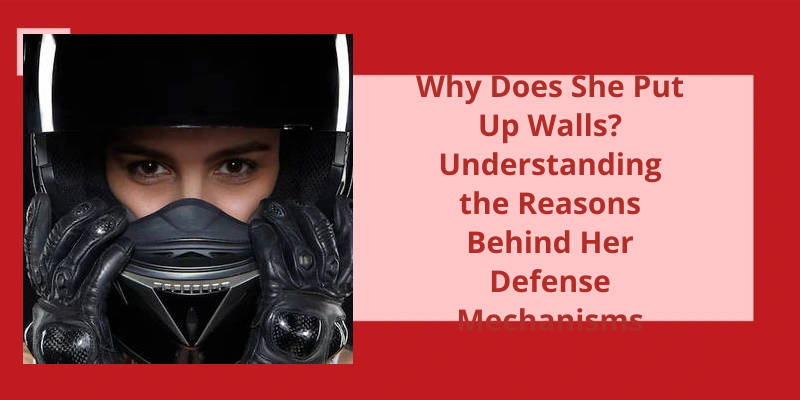Understanding the reasons behind why someone puts up emotional walls is key to unraveling the complex nature of human psychology. Often, people resort to these defense mechanisms as a means of self-preservation, shielding themselves from past traumas and pain. Delving into the intricacies of this phenomenon reveals the profound desire for control and the relentless pursuit of inner peace. To comprehend why she puts up walls, one must delve into the depths of her psyche, recognizing that these defense mechanisms aren’t mere walls, but complex labyrinthine structures that bind her emotions, experiences, and vulnerabilities into a hidden haven from which she struggles to escape.
Why Am I Putting Up Walls in My Relationship?
“Why Does She Put Up Walls? Understanding the Reasons Behind Her Defense Mechanisms”
Putting up walls in a relationship could stem from a deep-seated trauma pattern that’s wired into ones body and nervous system. These walls act as a defense mechanism to protect oneself from potential harm or retraumatization. Regardless of the current health and safety of ones partner, the nervous system tends to focus on the smallest reminders of past hurts.
This defensive behavior might be a result of a previous relationship or childhood experiences where trust was broken or emotional pain was inflicted. The walls are constructed as a means to shield oneself from vulnerability and potential pain. These defense mechanisms often operate on a subconscious level, making it challenging for the person to realize the negative impact they may have on their current relationship.
The walls go up out of self-preservation, creating an emotional barrier that prevents deep connection and intimacy from flourishing. The fear of being hurt again can be paralyzing, causing one to distance themselves and shut down emotionally. Over time, this can lead to a lack of trust and difficulty in forming or maintaining healthy relationships.
Understanding and addressing these defense mechanisms is crucial to breaking down the walls and fostering a more open and authentic connection. This may involve individual therapy or counseling to address and heal past traumas, as well as exploring healthier ways to communicate and build trust.
It’s important to remember that these walls aren’t a reflection of ones partner or their actions. Instead, they signify unresolved wounds that need to be acknowledged and healed. Patience, empathy, and open communication can be instrumental in helping someone feel safe enough to dismantle their emotional barricades and allow love and vulnerability to enter their lives once again.
The Connection Between Fear of Abandonment and Putting Up Walls
- Fear of abandonment
- Putting up walls
- Emotional barriers
- Past trauma
- Insecurity
- Lack of trust
- Self-preservation
- Vulnerability
- Fear of rejection
- Protecting oneself
Breaking down walls in communication is a crucial skill for establishing genuine connections. Oftentimes, when someone puts up barriers, acknowledging the existence of these walls is the initial step towards fostering open dialogue. By demonstrating empathy and understanding, we enable the person to confront the reasons behind their defenses, paving the way for a shared journey towards healing and building a secure and supportive environment.
How Do You Talk to Someone Who Puts Up Walls?
When faced with someone who puts up walls, it’s important to approach the situation with empathy and understanding. Before diving into a conversation about those walls, it’s crucial to first acknowledge their presence. By clearly articulating that you see and recognize the barriers this person has put up, you create a safe space for them to open up and share their experiences. This validation of their emotions can pave the way for a deeper discussion on why these walls exist and how they may be impacting the individuals well-being.
As you continue the conversation, it’s essential to emphasize that you’re there to support and help the person overcome their defense mechanisms. Assure them that your intentions come from a place of genuine care and concern, and that you’re committed to understanding their struggles. By displaying this level of commitment, you invite the person to engage in a process of self-reflection and self-growth.
Understanding the reasons behind someones defense mechanisms is key to fostering empathy and connection. Often, walls are built as protection, a shield against potential hurt or pain. By exploring the persons past experiences and understanding the specific triggers that influenced the creation of these walls, you can uncover the deeper roots of their behavior. This understanding allows you to address the underlying emotions and beliefs that contribute to the persons defensive stance.
By gently guiding the person through this introspective journey, you can help them realize how these walls may be limiting their growth and hindering their ability to form meaningful connections with others. It’s important to approach this process with patience and compassion, recognizing that tearing down these barriers takes time and effort. Encourage the person to step outside of their comfort zone and offer reassurance that you’ll be there to support them as they navigate this vulnerable terrain.
Ultimately, the goal is to create a safe and healing space that facilitates personal growth and genuine connection. By acknowledging the existence of walls, understanding the reasons behind them, and providing unwavering support, you can help someone begin the work of dismantling these defense mechanisms. With time, patience, and open communication, you can foster an environment where walls can be broken down, allowing for healthier, more authentic relationships to flourish.
How to Set Boundaries and Establish a Sense of Safety and Respect in Conversations With Someone Who Puts Up Walls
- Listen actively and empathetically to their concerns and feelings.
- Acknowledge their need for boundaries and let them know that their feelings are valid.
- Avoid judgment or criticism, as it can make someone reinforce their defensive walls.
- Use “I” statements to express your own thoughts and feelings instead of making them feel attacked.
- Respect their need for personal space and give them time to process their emotions.
- Be patient and persistent, showing them that you genuinely care about their well-being.
- Avoid pushing them to open up, but rather create a safe and non-threatening environment.
- Set clear and mutually agreed-upon boundaries for the conversation, ensuring both parties feel comfortable.
- Focus on building trust through open and honest communication over time.
- Practice active problem-solving and compromise to find common ground in the conversation.
- Celebrate small progress and achievements, reinforcing positive behavior.
Building walls in a marriage can stem from various sources, often rooted in feelings of uncertainty, constant disagreements, or unresolved conflicts. Some key triggers for putting up emotional barriers with our partners include doubts about their love and concern, regular angry outbursts, harmful language or threats, as well as the mutual ignorance of crucial issues within the relationship. Understanding these underlying factors can help unravel the reasons behind such walls and find ways to tear them down.
Why Do I Put Up Walls With My Husband?
Many couples may find themselves putting up walls in their relationship for various reasons. One of the common reasons is the feeling of uncertainty about whether our partner truly cares about or loves us. This may stem from a lack of open communication and a lack of affectionate gestures, leading us to build a defensive mechanism to protect ourselves from potential hurt or rejection.
Constant angry outbursts and demands can also contribute to the emergence of walls in a relationship. When one or both spouses frequently lash out in anger or make excessive demands, it creates an atmosphere of tension and fear. In response, individuals may choose to put up walls as a way to shield themselves from the constant emotional turmoil.
Harmful words and threats can be incredibly damaging to a relationship and can push someone to put up walls. When a partner consistently uses hurtful language or makes threats, it erodes trust and creates emotional distance between both parties. In order to protect themselves from further harm, individuals may instinctively raise defenses to shield themselves from the pain.
Another factor that can lead to walls being built is when one or both spouses ignore key issues in the relationship. Ignoring important topics or refusing to address issues can cause resentment to build up over time. This resentment can manifest in the form of emotional barriers and walls, as individuals may feel helpless in reaching a solution or in having their needs met.
It’s important to understand that these defense mechanisms aren’t always intentional or consciously chosen. They often develop as a response to emotional pain or distress within the relationship. By recognizing and understanding these reasons behind the walls, couples can begin to address the underlying issues and work towards creating a healthier, more open and connected relationship.
Conclusion
These defense mechanisms, such as emotional walls, provide individuals with a sense of control and protection from emotional pain. By separating themselves from certain events or experiences, they create a shielded space where they can navigate their anguish privately. It’s essential to approach these walls with sensitivity and patience, striving to understand the underlying reasons behind them. Through genuine support and understanding, one can help dismantle these walls and foster an environment of trust and healing.






